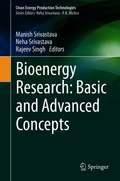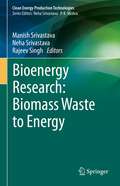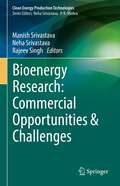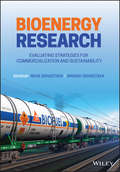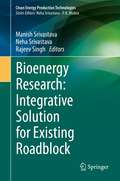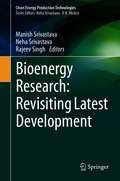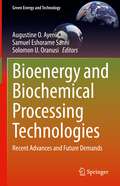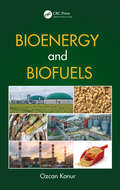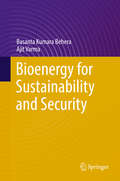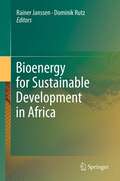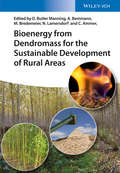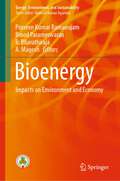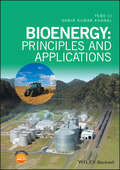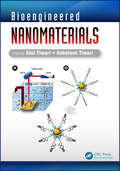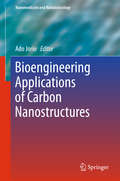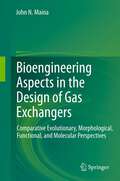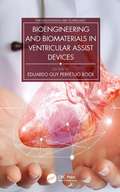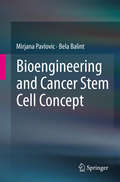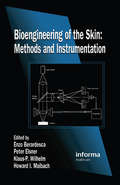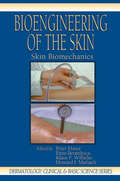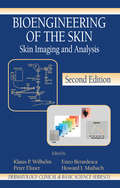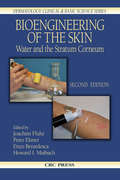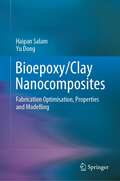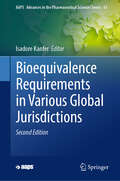- Table View
- List View
Bioenergy Research: Basic and Advanced Concepts (Clean Energy Production Technologies)
by Neha Srivastava Manish Srivastava Rajeev SinghThis volume is first part of the five-part set on bioenergy research. This volume covers current developments and both basic and advanced concepts in bioenergy production. Based on bioenergy road map, the book will also evaluate about the ratio existing between current challenges associated and practical implementation of these biofuels. The book complies up to-date progressive development in available bioenergy options and discusses opportunities and existing risks. The main objective of the book is to provide insights into the opportunities and required actions for the development of an economically viable bioenergy industry for practical replacement of fossil fuels. This book is of interest to teachers, researchers, scientists, capacity builders and policymakers. Also the book serves as additional reading material for undergraduate and graduate students of environmental sciences. National and international bioenergy scientists, policy makers will also find this to be a useful read. Other four volumes of this set explore latest developments, commercial opportunities, waste to energy and integrated solution for bioenergy concerns.
Bioenergy Research: Biomass Waste to Energy (Clean Energy Production Technologies)
by Neha Srivastava Manish Srivastava Rajeev SinghThis volume is fourth part of the five-part set on bioenergy research. This volume covers biomass to bioenergy production concept. The book is focused on the possible and versatile biomass options available for the generation of bioenergy. Additionally, the book also explores different types of biomass for bioenergy generation at a commercial level. Further, the book elaborates on different kind of cellulose and sugar rich waste which can also be utilized for bioenergy production. It covers other relevant issues such as recent technological advancement in biomass to bioenergy conversion, waste management in the context of biomass to biofuels production technologies, green methods of energy production, alternates of fossil fuels in the near future. It also explores biomass waste valorization, utilizing microbial processes in bioenergy production. This is a useful reading material for students, researchers, industry and policy experts.Other four volumes of this set explore basic concepts, latest progress, commercial opportunities and integrated solution for bioenergy concerns.
Bioenergy Research: Commercial Opportunities & Challenges (Clean Energy Production Technologies)
by Neha Srivastava Manish Srivastava Rajeev SinghThis volume is third part of the five-part set on bioenergy research. This book provides insights into commercial advantages of commonly running bioenergy options. It explores various opportunities present at technical scale to produce biofuels. Moreover, the additional practical feasibility of the commercialization of existing biofuels including existing challenges and sustainable solutions to overcome from these technical hurdles. This Volume also focuses on the durability and long run sustainability on the new arrival of biofuels options which can be a suitable and easy replacement of currently available biofuels at pilot scale. Other four volumes of this set explore basic concepts, latest progress, bio-waste to energy conversion and integrated solution for bioenergy concerns.
Bioenergy Research: Evaluating Strategies for Commercialization and Sustainability (Clean Energy Production Technologies Ser.)
by Neha SrivastavaBIOENERGY RESEARCH Evaluates challenges and sustainable solutions associated with various biofuel technologiesBioenergy Research offers an authoritative guide to recent developments in green bioenergy technologies that are currently available including: bioethanol, biobutanol, biomethanol, bio-oil, biohydrogen, biogas and biomethane. The authors provide in-depth analysis and discuss the commercial viability of the various technological advances in bioenergy. Comprehensive in scope, the book explores the environmental, practical and economic implications associated with a variety of bioenergy options. The book also considers the rollback of fossil fuels, the cost and their replacement as well as practical solutions for these issues.This important resource:Presents up-to-date research and industrial developments for various bioenergy optionsOffers comparative evaluation of bioenergy technologies for commercial feasibilityReviews current challenges and sustainable solutions for a variety of biofuel technologiesContains a review of existing strategies for bioenergy productionBioenergy Research is a valuable guide for academic researchers and industrial scientists working in the fields of biofuels and bioenergy, environmental science and technology, microbial technology, bioprocess engineering, and waste valorization.
Bioenergy Research: Integrative Solution for Existing Roadblock
by Neha Srivastava Manish Srivastava Rajeev SinghThis volume is fifth part of the five-part set on bioenergy research. This edited volume provides sustainable solution for all existing roadblocks in commercial bioenergy production. The book focuses on different types of obstacles involved in various bioenergy operations with detail remedy of the issue in a sustainable way. In spite of having number of potential advantages, all available bioenergy options are still far from smooth practical applicability, due to which they are still in pipeline phase to replace the fossil fuels. This book brings together the integrative approach to the readers, to connect with more viable bioenergy type on commercial scale, the existing issues and the feasible approaches to eliminate the bottlenecks in the process. Further, the book also uncovers the untouched area of bioenergy production technology by bringing forth unconventional methods, processes and parameters, which have scope to enhance biofuel production technology by “Lab to Land” methods. The book highlights aspect which are less studied or are very new in their industrial application of bioenergy production. The book presents relevant reading material for global researchers, academic institutions, research students, teachers, scientist as well as industries. Other four volumes of this set explore basic concepts, latest progress, commercial opportunities and bio-waste to energy conversion.
Bioenergy Research: Revisiting Latest Development (Clean Energy Production Technologies)
by Neha Srivastava Manish Srivastava Rajeev SinghThis volume is second part of the five-part set on bioenergy research. This book provides new insight about the latest development in bioenergy research. It presents the various bioenergy options which are further explored for practical viability, their progress and utility in the industry. The main objective of the book is to provide insights into the opportunities and required actions for the development of an economically viable bioenergy industry for practical replacement of fossil fuels. This book is of interest to teachers, researchers, scientists, capacity builders and policymakers. Also the book serves as additional reading material for undergraduate and graduate students of environmental sciences. National and international bioenergy scientists, policy makers will also find this to be a useful read. Other four volumes of this set explore basic concepts, commercial opportunities, waste to energy and integrated solution for bioenergy concerns.
Bioenergy and Biochemical Processing Technologies: Recent Advances and Future Demands (Green Energy and Technology)
by Augustine O. Ayeni Samuel Eshorame Sanni Solomon U. OranusiThis book presents novel techniques, current trends, and cutting-edge technologies in energy and biochemical processes. The authors explore recent advances that solve challenges related to the implications and commercialization of these processes by introducing new techniques or modifying existing technologies to meet future demands for food materials, bioproducts, fossil fuels, biofuels, and bioenergy. Divided into three parts, the first section of the book addresses issues related to the utilization and management of energy towards the efficient characterization and conversion of wastes or raw-/bio- materials to useful products. The second section focuses largely on studies on molecular detection of analytes, purification, and characterization of products recovered from biochemical, enzymatic, food, and phytochemicals, as well as biostimulation and bioaugmentation processes. The final section discusses areas related to heat and mass transfer, fuel processing technologies, nanofluids, and their applications.
Bioenergy and Biofuels
by Ozcan KonurThis book aims to inform readers about the recent developments in bioenergy and biofuels covering current issues from an interdisciplinary approach. It will also feature coverage of anticipated future trends related to each particular biofuel. Chapters will consist of original research presented by world class experts in their respective fields. A number of interdisciplinary areas will be incorporated such as Energy & Fuels, Biotechology, Genomics, Economics, Optimization, Chemical Engineering, Mechanical Engineering and Algae Science. Examples will relate to a matrix of biofuel and energy types such as bioethanol, biobutanol, and biomethane.
Bioenergy and Environmental Biotechnology for Sustainable Development (Multidisciplinary Applications and Advances in Biotechnology)
by Akinola Rasheed PopoolaThis book covers a range of important topics on environmental remediation, biofuels and value-added microbial products for environmental clean-up, water and wastewater recycling and sustainable wastewater treatment using microalgae. Designed to document advances in biotechnology, this book highlights bio-resource utilization in fostering low-carbon renewable energy-based economies and provides new insights into chlorine disinfectant usage in water treatment, wastewater treatment using microalgae, etc. The book will be useful reference material for scientists and researchers in the fields of microbial biotechnology and bioremediation, environmental biotechnology and sustainable development, climate change mitigation, provision of safe water and sustainable wastewater recycling. Emphasizes recent advances in bioremediation techniques towards environmental sustainability Provides detailed information on how to harness indigenous bio-resources including microorganisms as bioenhancement agents for environmental remediation Introduces new frontiers in the area of wastewater treatment using microalgae — important for sustainability and water safety Reviews biotechniques that could enhance higher levels of sustainability in heavily polluted environments and also provides an intelligent monitoring system for waste recycling and environmental remediation, and fostering a low-carbon renewable energy–based bioeconomy Discusses the need for review of existing guidelines on chlorine disinfectant usage for enhanced water quality Akinola Rasheed Popoola, Ph.D., is a Professor of Plant Pathology and the Director of the Biotechnology Centre, Federal University of Agriculture, Abeokuta, Nigeria. Emeka Godfrey Nwoba, Ph.D., is a research scholar at the Algae Research & Development Centre, Murdoch University, Western Australia. James Chukwuma Ogbonna, Ph.D., is a Professor of Microbiology and Biotechnology and Director, National Biotechnology Development Agency, South East Zonal Biotechnology Centre, University of Nigeria, Nsukka, Nigeria. Charles Oluwaseun Adetunji, Ph.D., is an Associate Professor of Microbiology and Biotechnology, and Director of Intellectual Property and Technology Transfer, Edo State University, Uzairue, Nigeria. Nwadiuto (Diuto) Esiobu, Ph.D., is a Professor of Microbiology and Biotechnology at Florida Atlantic University, Boca Raton, FL, USA, and the President and Founder of Applied Biotech Inc. and ABINL, Abuja, Nigeria. Abdulrazak B. Ibrahim, Ph.D., is a Capacity Development Expert at the Forum for Agricultural Research in Africa (FARA) and an Associate Professor of Biochemistry, Ahmadu Bello University, Zaria, Nigeria. Benjamin Ewa Ubi, Ph.D., is a Professor of Plant Breeding and Biotechnology and Director, Biotechnology Research and Development Centre, Ebonyi State University, Abakaliki, Nigeria.
Bioenergy for Sustainability and Security
by Ajit Varma Basanta Kumara BeheraThis book discusses the generation of green energy, providing fundamental scientific information on the availability of sustainable biological resources. It addresses inter- and multidisciplinary topics, including policies and strategies for sustainable energy; the environment and advanced renewable energy technology; electricity generation through solid waste management; and direct electricity generation using microbial fuel cells. It examines the application of the principles and quantitative relationships that define the process – as an effective technique to teach applied aspects of biomass energy technology conversion. In addition, it describes the latest commercialisation of microbial fuel cell technologies, bio-diesel production from microalgae, fermentation technology based on biobutanol from bacteria, and direct ethanol production from microalgae with attractive illustrations and models developed by corporate sectors.
Bioenergy for Sustainable Development in Africa
by Dominik Rutz Rainer JanssenThe work builds on the results of the COMPETE Bioenergy Competence Platform for Africa, which was supported by the European Commission and coordinated by WIP Renewable Energies, Germany. The five sections cover biomass production and use, biomass technologies and markets in Africa, biomass policies, sustainability, and financial and socio-economic issues. This valuable work is, in effect, a single-source treatment of a key energy sector in a part of the world which still has a lot of unrealised potential for development.
Bioenergy from Dendromass for the Sustainable Development of Rural Areas
by Albrecht Bemmann Michael Bredemeier Christian Ammer Norbert Lamersdorf David Butler ManningBased on the results of two bioenergy research initiatives in Germany, this reference examines the sustainable management of wood biomass in rural areas. The large number of participating organizations and research institutes ensures a balanced and unbiased view on the potentials and risks is presented, taking into account economic, ecological, and social aspects. Most of the results reported are available here for the first time in English and have been collated in central Europe, but are equally applicable to other temperate regions. They highlight best practices for enhancing dendromass potential and productivity, while discussing the implications on rural economies and ecosystems.
Bioenergy: Impacts on Environment and Economy (Energy, Environment, and Sustainability)
by Binod Parameswaran B. Bharathiraja Praveen Kumar Ramanujam A. MageshThis contributed volume discusses the impact of bioenergy on the environment and economy. The book contents include contributions on themes, such as the impact of emulsified biofuels on the environment, environmental impacts of the current uses of biomass energy, sustainable development in ecosystem, trends in microbial fuel cells and the ecological and economic impacts on biofuel production, among others. The book also uses visual elements to aid learning. This book is a valuable, hands-on resource for researchers, academics and industry professionals, who are interested in alternative fuels, sustainability, clean energy, biofuel production, waste management, environmental pollution, renewable energy and allied fields.
Bioenergy: Principles and Applications
by Yebo Li Samir Kumar KhanalThe search for altenative, renewable sources of fuel and energy from plants, algae, and waste materials has catalyzed in recent years. With the growing interest in bioenergy development and production there has been increasing demand for a broad ranging introductory text in the field. Bioenergy: Principles and Practices provides an invaluable introduction to the fundamentals of bioenergy feedstocks, processing, and industry. Bioenergy provides readers with an understanding of foundational information on 1st, 2nd, and 3rd generation biofuels. Coverage spans from feedstock production of key energy sources such as grasses, canes, and woody plants through chemical conversion processes and industrial application. Each chapter provides a thorough description of fundamental concepts, definitions of key terms, case studies and practical examples and exercises. Bioenergy: Principles and Practices will be an essential resource for students, bioengineers, chemists, and industry personnell tying key concepts of bioenergy science to valuable real world application.
Bioengineered Nanomaterials
by Atul Tlwarl Ashutosh TlwarlMany varieties of new, complex diseases are constantly being discovered, which leaves scientists with little choice but to embrace innovative methods for controlling the invasion of life-threatening problems. The use of nanotechnology has given scientists an opportunity to create nanomaterials that could help medical professionals in diagnosing and
Bioengineering Applications of Carbon Nanostructures (Nanomedicine and Nanotoxicology)
by Ado JorioThis book covers the development of biotechnology based on carbon nanostructures, with a focus on nanotubes, addressing also fullerenes and amorphous carbons. The book is divided into 7 chapters, addressing tissue engineering, genetic engineering and therapy, as well as the environmental and health impacts of carbon nanostructures.
Bioengineering Aspects in the Design of Gas Exchangers: Comparative Evolutionary, Morphological, Functional, and Molecular Perspectives
by John N. MainaThis book encapsulates over three decades of the author's work on comparative functional respiratory morphology. It provides insights into the mechanism(s) by which respiratory means and processes originated and advanced to their modern states. Pertinent cross-disciplinary details and facts have been integrated and reexamined in order to arrive at more robust answers to questions regarding the basis of the functional designs of gas exchangers. The utilization of oxygen for energy production is an ancient process, the development and progression of which were underpinned by dynamic events in the biological, physical, and chemical worlds. Many books that have broached the subject of comparative functional respiratory biology have only described the form and function of the 'end-product,' the gas exchanger; they have scarcely delved into the factors and the conditions that motivated and steered the development from primeval to modern respiratory means and processes. This book addresses and answers broad questions concerning the critical synthesis of multidisciplinary data, and clarifies previously cryptic aspects of comparative respiratory biology.
Bioengineering and Biomaterials in Ventricular Assist Devices (Emerging Materials and Technologies)
by Eduardo Guy Perpétuo BockOften associated with artificial hearts, ventricular assist devices (VADs) are blood pumps that can provide circulatory assistance to the left ventricle, the right ventricle, or both. Bioengineering and Biomaterials in Ventricular Assist Devices reviews constructive details of VADs and the biomaterials used in their development and support. FEATURES Establishes an area of intersection between engineering and medicine Shows process development from mechanical design to automation and control Discusses biofunctional materials, tribology in ceramic biomaterials, biosensors, and surface engineering and blood This text is aimed at advanced students, researchers, and practicing engineers conducting work on VADs and will be of interest to a broad interdisciplinary group, including bioengineers, materials engineers, chemical engineers, mechanical engineers, and electrical engineers.
Bioengineering and Cancer Stem Cell Concept (SpringerBriefs in Computer Science #0)
by Bela Balint Mirjana PavlovicThis book explores the role of cancer stem cells in the diagnosis, treatment, and cure of cancers. This book also tackles novel methodology for cancer stem cell marker identification, cancer stem cell respiration and metabolism, genetic and epigenetic mechanisms including DNA methylation, and mi-RNA assemble. It also emphasizes the role of Bioinformatics techniques, which provide a novel methodology for modeling cancer outcomes. The authors investigate the difference between cancer stem cells and normal stem cells, along with the concept of targeted cancer stem cell therapy. Although the theoretical explanations of cancer stem cell involvement in leukemia and solid cancers are controversial, there is now little doubt that cancer stem cells exist within otherwise heterogeneous cancer cell population. The brief examines the two leading theories, hierarchical and the stochastic/cancer stem cell model. Researchers, professors and advanced-level students focused on bioengineering and computer science will find this book to be a valuable resource. It is a very good source of critical references for understanding of this problem, and a useful tool for professionals in related fields.
Bioengineering of the Skin: Methods and Instrumentation, Volume III (Dermatology: Clinical And Basic Science Ser. #9)
by Howard I. Maibach Peter Elsner Enzo Berardesca Klaus-P. WilhelmSkin bioengineering is an expanding field of investigative and clinical dermatology. This guide describes all commercially available techniques and instruments. It provides a thorough overview of methods for noninvasive investigation of skin function. Commercially available instruments are reviewed and compared, with updated references given for each instrument. This book offers a technical analysis of each instrument, allowing investigators to understand its biophysical principles and to make better purchases of lab instruments. Addresses of manufacturers and worldwide distributors are included, making this an essential reference source.Chapters are written by international experts. Topics include transepidermal water loss, hydration, the measurement of skin blood flow in Laser-Doppler flowetry, sebum, pH and ions, and transcutaneous pO2 and pO2 measurements. Skin color, roughness, and elasticity are examined in detail. Skin imaging techniques, capillaroscopy, and fluorescence videomicroscopy are described. Instruments for surface microscopy of the skin are also discussed.Bioengineering of the Skin explains state-of-the-art techniques and is valuable reading for anyone who needs to stay abreast of the latest activities in this ever-changing field.
Bioengineering of the Skin: Skin Biomechanics, Volume V
by Howard I. Maibach Peter Elsner Enzo Berardesca Klaus P. WilhelmSince skin forms the interface between the human body and the environment, its mechanical properties are important in health and disease. Bioengineering of the Skin: Skin Biomechanics gives a thorough introduction in the biological basis of skin biomechanics. It explains the non-invasive methods that allow measurement of the mechanical properties o
Bioengineering of the Skin: Skin Imaging & Analysis (Dermatology: Clinical & Basic Science)
by Howard I. Maibach Peter Elsner Enzo Berardesca Klaus-P. WilhelmSpanning the many advancements that have taken place in the field since the First Edition of this book was published, this Second Edition emphasizes the imaging of the skin in its entirety, rather than focusing solely on surface layers. The Second Edition includes new chapters on technologies such as in vivo confocal laser scanning microscopy, Rama
Bioengineering of the Skin: Water and the Stratum Corneum, 2nd Edition (Dermatology: Clinical & Basic Science)
by Joachim Fluhr Peter ElsnerBioengineering of the skin, or more precisely the biophysical assessment of skin physiology, is moving rapidly from a descriptive approach to a deeper understanding of biophysical and biochemical processes. This second edition of the popular text Bioengineering of the Skin: Water and Stratum Corneum reflects the progress in the field, focusing on t
Bioepoxy/Clay Nanocomposites: Fabrication Optimisation, Properties and Modelling
by Yu Dong Haipan SalamThis book highlights current advanced developments in bioepoxy and bioepoxy/clay nanocomposites and an optimisation of material formulation and processing parameters on fabrication of bioepoxy/clay nanocomposites in order to achieve the highest mechanical properties in relation to their morphological structures, thermal properties, as well as biodegradability and water absorption, which is based on the use of Taguchi design of experiments with the consideration of technical and economical point of view. It also elaborates holistic theoretical modelling of tensile properties of such bionanocomposites with respect to the effect of contents of nanoclay fillers and epoxydised soybean oil (ESO).
Bioequivalence Requirements in Various Global Jurisdictions (AAPS Advances in the Pharmaceutical Sciences Series #61)
by Isadore KanferAn important objective of Bioequivalence Requirements in Various Global Jurisdictions is to attempt to gather current and updated information, collated in a single source, regarding the various bioequivalence and related requirements to satisfy the regulatory requirements for the market approval of multi-source (generic) drug products in various global jurisdictions. In view of the dynamic nature of regulatory requirements which are usually regularly updated, updating these requirements to remain current is an important necessity to provide such information to drug manufacturers, regulatory agencies, pharmaceutical scientists and related health organizations and governments around the world in the quest to harmonize regulatory requirements for the market approval of generic products. The revised volume includes updated information based on recent guidances and guidelines from the respective regulatory agencies as well as important trends and descriptions relating to innovative approaches for bioequivalence assessment.
